ORTHODONTIC SURGERY
Dysgnathia
The Greek word “dysgnathia” refers to irregularities in the structure of the mid-facial bones and the lower jaw. Improper alignment can affect not only the facial profile, but also the bite, chewing ability, and breathing through the nose.
Often very complex, the irregularities are categorized by their discrepancy from the norm in the following planes:
- Sagittal
- Transverse
- Vertical
- Combined Malalignments

 1. Sagittal Malalignment - Lower Jaw
1. Sagittal Malalignment - Lower JawOverbites and Underbites
DThis type of malalignment is not necessarily dependent on only one jaw. For example, a posterior position of the upper jaw may give the impression of a prominent lower jaw. Similarly, the illusion of a posterior position of the lower jaw may be created by a prominent upper jaw.
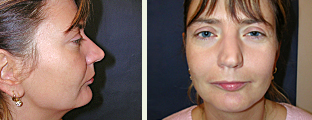
Overbite (mandibular retrognathism)
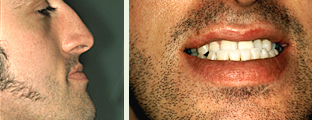
Underbite (mandibular prognathism)
Operation:
The Obwegeser-Dal Pont technique, named after its developers, has been used in lower jaw surgeries for about 50 years. The advantage of this technique is that the bone segments have large overlapping surface areas, creating optimal conditions for proper healing. However, there is the risk of permanent damage to the nerve transmitting sensation from the lower lip (the inferior alveolar nerve), which runs through the vicinity of the overlap.
The development of modern bone-stabilizing techniques (osteosynthesis) allows for a departure from the traditional method. The lower jaw bone can be transected much higher in the mandibular ramus, resulting in a less invasive procedure. This operation takes place in an area farther from the mandibular nerve, minimizing the risk of nerve damage. Small titanium plates and specially designed static screws stabilize the repositioned jaw segments.

 1. Sagittal Malalignment - Short Upper Jaw
1. Sagittal Malalignment - Short Upper JawAlthough this patient appears to have a prominent lower jaw, critical analysis of the profile and the measurements indicates a posterior positioned upper jaw.
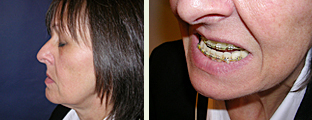
Short upper jaw
Operation:
The upper jaw is accessed exclusively through the mouth while the patient is under general anesthesia. The upper jaw is detached from the mid-facial bones along the floor of the nose, above the roots of the teeth. It can then be raised, tilted, or rotated, according to preoperative planning. Pre-made plastic splints hold the jaw in place, stabilizing the new alignment. The patient is generally hospitalized for 3 days.
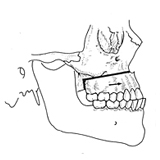
After the upper jaw is moved forward, the underbite is normalized and the patient enjoys a more harmonious profile.
 2. Transverse Plane
2. Transverse PlaneDiscrepancies from the norm in this plane affect the width of the upper or lower jaw. Treatment is required if the jaw is too narrow, causing the teeth to be crowded.
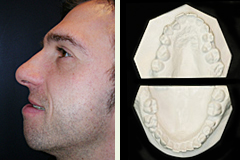
Transverse plane
Operation:
Surgical expansion of the palate seam via traction (stretching treatment) is used to widen the upper jaw of an adult. In an operation under general anesthesia, the upper jaw is detached from the surrounding structures and a palatal expander is put into place. In the postoperative phase, this device continually pushes the segments of the upper jaw apart via a jack screw, creating enough space to eliminate the crowding.
After several weeks of stretching, a retention period is necessary to prevent the segments from migrating back to their original position.
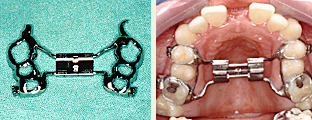
Stretching phase - palate seam expansion
 3. Vertical Plane
3. Vertical PlaneIrregularities in the vertical facial position can be manifested in a “gummy smile”.
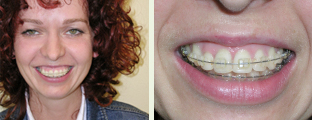
Gummy smile
An “open bite,” where the incisors do not come together at the front of the mouth, is another common symptom of an irregularity in the vertical plane. Also common with vertical jaw malalignment are problems with breathing through the mouth and limited airflow through the nasal passages. These conditions are often improved by the operation.
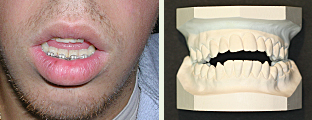
Open bite
Operation:
The upper jaw is accessed exclusively through the mouth while the patient is under general anesthesia. The upper jaw is detached from the mid-facial bones along the floor of the nose, above the roots of the teeth. It can then be raised, tilted, or rotated, according to preoperative planning. Pre-made plastic splints hold the jaw in place, stabilizing the new alignment. In order to close an open bite at the front of the mouth, it is necessary to lift the back of the upper jaw, tilting it forward in a process called cranialization. The patient is generally hospitalized for 3 days.
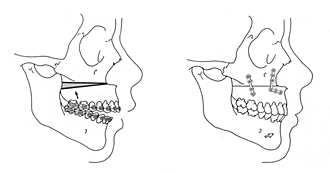
 4. Combined Malalignments
4. Combined MalalignmentsFacial malalignment in more than one plane results in a combination of several different symptoms. The “laterognathia” (lateral malalignment) is particularly noticeable in the frontal view.

Combined malalignments
Operation:
Surgical adjustment of the upper and lower jaws is generally required to correct complex cases of combined malalignments. The jaws are repositioned in three dimensions so as to normalize the profile and bite. The patient is generally hospitalized for 3 to 4 days.

Berlin 2010, Dr. med. Dr. med. dent. Herbert Kindermann